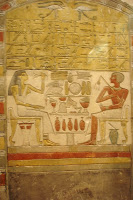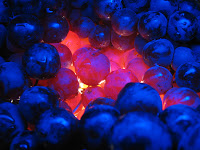Did you realise that originally there were no white grapes? Grape vines only bore red grapes until 3 000 years ago.  ABC Science Online has reported that Australian Scientists have discovered that white grapes evolved due to a lucky genetic coincidence.
ABC Science Online has reported that Australian Scientists have discovered that white grapes evolved due to a lucky genetic coincidence.
Dr Mandy Walker from CSIRO Plant Industry in Adelaide and her colleagues studied the genetics of Vitis vinifera, the grapevine species used to produce almost all the white and red wine varieties sold today.
The new research, published in the latest issue of the Plant Journal, showed that the colour of grape skins is controlled by two genes, VvMY BA1 and VvMYBA2.

They found that either gene can regulate the colour by switching on production of a molecule called anthocyanin, which turns grape skin red. In white grapes, both the genes are mutated, meaning both ways for producing a red colour were switched off.
Mutations in single genes happen at a fairly low frequency, but the grapes had to have mutations in two genes to turn from red to white and that’s just very, very rare.
The researchers studied more than 55 different strains of white grape from around the globe and all of them contained both mutations.  The evidence suggests that all the white grape varieties have a single genetic ancestor.
The evidence suggests that all the white grape varieties have a single genetic ancestor.
So when did the red grapes turn white? The Scientists think it would have most likely occurred before the time of Tutankhamen. White wine residue was found in flasks within the ancient Egyptian king’s tomb. Maybe some erstwhile Egyptian ambling through his vineyard saw these strange new white grapes and wondered whether they’d make good wine.
Tutankhamen was buried with jars of wine to ease his passage into the afterlife.  The Ancient Egyptians believed in life after death. Their favourite possessions and practical objects were buried wit h them to accompany their spirits into the afterlife. Pottery wine jars were such common treasures.
The Ancient Egyptians believed in life after death. Their favourite possessions and practical objects were buried wit h them to accompany their spirits into the afterlife. Pottery wine jars were such common treasures.
Wine was a product of great importance, offered in funerary rituals and in temples to worship gods and consumed daily by the upper classes and the kings. Each jar carried an inscription saying where the wine was made, who made it, and how old it was.
Of the 6 jars found in Tutankhamen’s tomb 5 contained white wine. Three of them were made in the Western Nile Delta in an estate owned by the Temple of the god Aton, near modern Alexandria. An amphora marked “Year 5. Sweet wine of the Estate of Aton of the Western River. Chief v intner Nakht” also had white wine, as did another given to Tutankhamen by his vizier. This may indicate that white wine was highly valued in Egypt since only the best products were offered for the afterlife of the Pharaoh.
An amphora marked “Year 5. Sweet wine of the Estate of Aton of the Western River. Chief v intner Nakht” also had white wine, as did another given to Tutankhamen by his vizier. This may indicate that white wine was highly valued in Egypt since only the best products were offered for the afterlife of the Pharaoh.
Until these wines were found in Tutankhamen’s tomb the earliest reference to white wine in Egypt came from the Greek Athenaeus (170 — 230 AD) who praised wine from a region near Alexandria as white, pleasant, fragrant and “not likely to go to the head”.
The ancient Romans, who had quite a lot of vineyards of their own, also imported wines from Egypt. They considered the vineyards along the Canopic branch of the Nile to have some the best wines. Two writers during the Roman empire record the wine at Mareotis is white, fragran t, thin, but of good quality.

It appeared that ancient Egypt had the equivalent of the French ‘Appellation Controlee’ laws. Keeping a wine for years to mature was not all that uncommon. There was a “Royal Sealer of Wine” who overlooked the honest labelling laws, and much of what you find on wine labels today were on the wine labels of ancient Egypt. These included the Name of the Estate, Location, Type of wine, Date of vintage, Vintners Name, and Assessment of Quality.
Egyptian wines were graded as good (nfr), twice good (nfr, nfr), three times good (nfr, nfr, nfr) as being the finest. There was also another type of gradi ng; genuine, sweet, merrymaking (not so good), and blended.
finest. There was also another type of gradi ng; genuine, sweet, merrymaking (not so good), and blended.
Something we don’t do today is to label the wine with the name of the vintner. It was important in ancient Egypt since if the vintner was famous for producing fine wines and moved to another vineyard, it would be a way that the Egyptian wine buyer could continue buying fine wine.
Today we keep track to the movement of vintners through wine magazines and newsletters. We know that many nobles’ tombs have paintings of specially constructed storehouses in which the wine amphorae were stacked in rows on shelves, giving us a glimpse of the first true wine cellars.
 It would be fascinating to find out what varieties of grapes were used to make these ancient white wines.
It would be fascinating to find out what varieties of grapes were used to make these ancient white wines.
However, the Scientists are keener to use the new genetic information as a tool for breeding new grape varieties with specific colour characteristics.
I am afraid this looks as if we are in for yet more tampering with the grape – will we end up with a rainbow hued one in the future?


